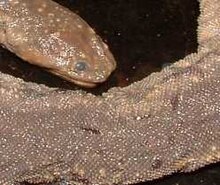Elephant trunk snake
| Elephant trunk snake | |
|---|---|

| |
| Preserved specimen | |
| Scientific classification | |
| Kingdom: | Animalia |
| Phylum: | Chordata |
| Class: | Reptilia |
| Order: | Squamata |
| Suborder: | Serpentes |
| Family: | Acrochordidae |
| Genus: | Acrochordus |
| Species: | A. javanicus
|
| Binomial name | |
| Acrochordus javanicus Hornstedt, 1787
| |
Acrochordus javanicus, commonly known as the elephant trunk snake or the Javan file snake, is a species of snake in the family Acrochordidae, a family which represents a group of primitive non-venomous aquatic snakes. The species is also kept as an exotic pet.
Description[]
Acrochordus javanicus possesses a wide and flat head, and its nostrils are situated on the top of the snout. Those head particularities confer to A. javanicus a certain resemblance with boas. However, its head is only as wide as its body. Females are bigger than males, and the maximum total length (including tail) of an individual is 2.4 m (94 in). The dorsal side of the snake's body is brown, and its ventral side is pale yellow.[2]
The skin is baggy and loose[3] giving the impression that it is too big for the animal. The skin is covered with small rough adjacent scales. The skin is also used in the tannery industry.[1][2]
The top of the head has no large shields, but instead is covered with very small granular scales. There are no ventral scales. The body scales are in about 120 rows around the body. The body is stout, and the tail is short and prehensile.[4]
A. javanicus is fully adapted to live underwater so much that its body cannot support its weight out of water and leaving the water can cause it serious injury.[citation needed]
Reproduction[]
An aquatic snake, A. javanicus is ovoviviparous, with the incubation lasting 5 to 6 months and the female expelling 6 to 17 young.[1]
Geographic range[]
Acrochordus javanicus is found in South-East Asia west of the Wallace Line:[1] southern Thailand, the west coast of Peninsular Malaysia, Singapore, Borneo (Kalimantan, Sarawak), a number of Indonesian islands (Java, Sumatra, and (possibly) Bali);[1][5] possibly also in Cambodia[6] and Vietnam,[5][6] although the last is discredited by the IUCN.[1]
Habitat[]
Acrochordus javanicus has a coastal living habitat like rivers, estuaries and lagoons. But it prefers freshwater and brackish environments.[2]
Feeding[]
Acrochordus javanicus is an ambush predator that preys on fishes and amphibians. It usually catches its prey by folding its body firmly around the prey. Its loose, baggy skin and its sharp scales find their utility by limiting any risk of escape of the prey, in particular fishes which have bodies covered with a viscous, protective mucus.[2]
Behaviour[]
Acrochordus javanicus is nocturnal. It spends most of its life under water and rarely goes on land. It can stay under water for up to 40 minutes.[2]
Original publication[]
- Hornstedt CF (1787). "Beskrifning på en Ny Orm från Java ". Kongl. Vetenskaps Akademiens Handlingar 4: 306-308 + Plate XII. (Acrochordus javanicus, new species). (in Latin and Swedish).
References[]
- ^ Jump up to: a b c d e f Sanders K, Grismer L, Chan-Ard T (2012). "Acrochordus javanicus ". IUCN Red List of Threatened Species. 2012: e.T176718A1443749. doi:10.2305/IUCN.UK.2012-1.RLTS.T176718A1443749.en.
- ^ Jump up to: a b c d e Chiu K (1999). "Acrochordus javanicus Javan File Snake, Elephant Trunk Snake". Animal Diversity Web.
- ^ Durso, Andrew (30 August 2014). "Filesnakes, Wartsnakes, or Elephant Trunksnakes". Life is Short, but Snakes are Long. Retrieved 27 February 2016.
- ^ Boulenger GA (1893). Catalogue of the Snakes in the British Museum (Natural History). Volume I., Containing the Families Typhlopidæ, Glauconiidæ, Boidæ, Ilysiidæ, Uropeltidæ, Xenopeltidæ, and Colubridæ Aglyphæ, part. London: Trustees of the British Museum (Natural History). (Taylor and Francis, printers). xiii + 448 pp. + Plates I-XXVIII. (Genus Acrochordus and species A. javanicus, p. 173).
- ^ Jump up to: a b Wallach, Van; Williams, Kenneth L.; Boundy, Jeff (22 April 2014). Snakes of the World: A Catalogue of Living and Extinct Species. CRC Press. pp. 6–7. ISBN 978-1-4822-0848-1.
- ^ Jump up to: a b Acrochordus javanicus at the Reptarium.cz Reptile Database. Accessed 27 February 2016.
External links[]
- http://www.marinespecies.org/aphia.php?p=taxdetails&id=344014
- https://www.ncbi.nlm.nih.gov/Taxonomy/Browser/wwwtax.cgi?lin=s&p=has_linkout&id=39267
- Javan Filesnakes at Life is Short but Snakes are Long
Further reading[]
- Smith MA (1943). The Fauna of British India, Ceylon and Burma, Including the Whole of the Indo-Chinese Sub-region. Reptilia and Amphibia. Vol. III.—Serpentes. London: Secretary of State for India. (Taylor and Francis, printers). xii + 583 pp. (Acrochordus javanicus, pp. 132–134, Figure 43).
- IUCN Red List least concern species
- Acrochordidae
- Reptiles described in 1787
- Snakes of Southeast Asia
- Reptiles of Indonesia
- Reptiles of Malaysia
- Reptiles of Singapore
- Reptiles of Thailand
